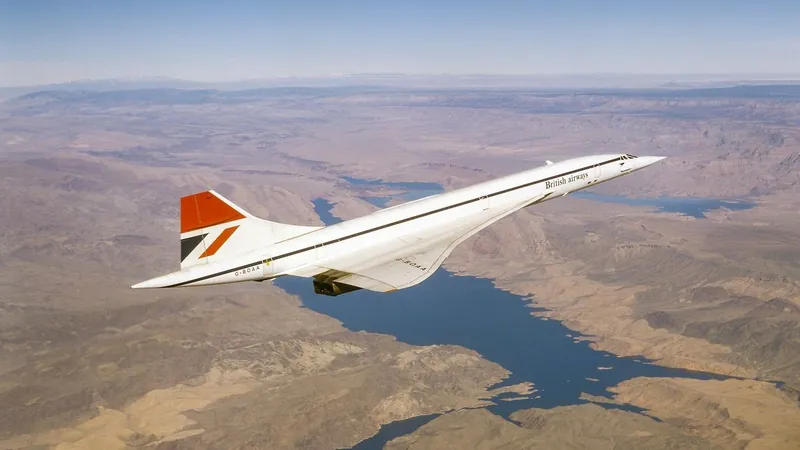
Unveiling the Secrets of the Concorde's Supersonic Speed: How Did It Fly So Fast?
2024-11-10
Author: Jia
The Concorde, an iconic passenger jet, achieved an astounding record by flying between New York City and London in just 2 hours, 52 minutes, and 59 seconds. Known for exceeding twice the speed of sound, this supersonic marvel raises an intriguing question: what enabled it to travel at such breathtaking speeds?
Operational from 1976 until its retirement in 2003, the Concorde boasted a takeoff speed of 250 mph (402 km/h) and an average cruising speed of 1,350 mph (2,173 km/h). In contrast, modern commercial aircraft, like the Boeing 737-700, have a takeoff speed of 173 mph (278 km/h) and a cruising speed of only 514 mph (828 km/h). The Concorde was in a league of its own, literally re-defining air travel.
Tony Farina, an adjunct assistant professor of aviation engineering at Embry-Riddle Aeronautical University, explained that to achieve such high speeds while maintaining safety during takeoff and landing, Concorde engineers faced a unique challenge. "A wing designed for supersonic speeds is often inefficient for low-speed lift needed during takeoff and landing," he elaborated.
To combat drag, the design for supersonic wings is typically thinner and more swept back compared to conventional wings. This created a challenging environment where high speeds resulted in increased drag forces, further complicating lift generation, according to Bob van der Linden, an aeronautics curator at the Smithsonian's National Air and Space Museum.
The Concorde’s solution to these aerodynamic challenges was the implementation of a sleek body design, featuring a narrow passenger cabin and an extended tail cone, although it was primarily the use of a delta wing that was crucial. Van der Linden noted that this triangle-shaped wing profile, often seen in fighter jets, optimized both high-speed and low-speed performance—making it exceptionally capable in supersonic flight.
However, this innovative design came with its own set of quirks. The aircraft had to land with its nose angled upward, which hindered pilot visibility. Van der Linden mentioned that engineers tackled this issue by creating a mechanism known as a "droop snoot," allowing the nose to lower during landing for better visibility—a significant feat of engineering.
Interestingly, while the Concorde was constrained by the technology of its era, modern supersonic aircraft designs, like the Boom Supersonic XB-1, leverage cutting-edge augmented vision systems that eliminate the need for such adaptations, showcasing how far aerospace technology has come.
To propel its impressive speed, Concorde relied on four turbojet engines, each capable of generating 18.7 tons of thrust and consuming nearly 7,000 gallons (26,000 liters) of jet fuel per hour—far exceeding the fuel consumption of the Boeing 737-800, which uses about 850 gallons (3,200 liters) per hour.
These engines utilized afterburners, a feature typical of military jets, which involved injecting additional fuel into the exhaust stream, significantly boosting thrust at the cost of higher fuel consumption. While this engineering marvel was capable of incredible speed, the significant operational cost associated with fuel consumption, combined with tragic incidents such as the Air France Flight 4590 crash in 2000, ultimately led to its decline in commercial viability.
In retrospect, while the Concorde was undoubtedly a masterpiece of aviation engineering, bringing luxury travel to new heights, it faced the sobering reality of fuel economics. Van der Linden aptly summarized the Concorde's legacy: "It is a gorgeous airplane, but to maintain such speed you need substantial power—which translates to immense fuel costs. And those costs, in today’s economy, proved too high to sustain." This legacy leaves us wondering: could we see another supersonic passenger jet taking to the skies in the future? Stay tuned as aviation continues to evolve!




 Brasil (PT)
Brasil (PT)
 Canada (EN)
Canada (EN)
 Chile (ES)
Chile (ES)
 Česko (CS)
Česko (CS)
 대한민국 (KO)
대한민국 (KO)
 España (ES)
España (ES)
 France (FR)
France (FR)
 Hong Kong (EN)
Hong Kong (EN)
 Italia (IT)
Italia (IT)
 日本 (JA)
日本 (JA)
 Magyarország (HU)
Magyarország (HU)
 Norge (NO)
Norge (NO)
 Polska (PL)
Polska (PL)
 Schweiz (DE)
Schweiz (DE)
 Singapore (EN)
Singapore (EN)
 Sverige (SV)
Sverige (SV)
 Suomi (FI)
Suomi (FI)
 Türkiye (TR)
Türkiye (TR)
 الإمارات العربية المتحدة (AR)
الإمارات العربية المتحدة (AR)